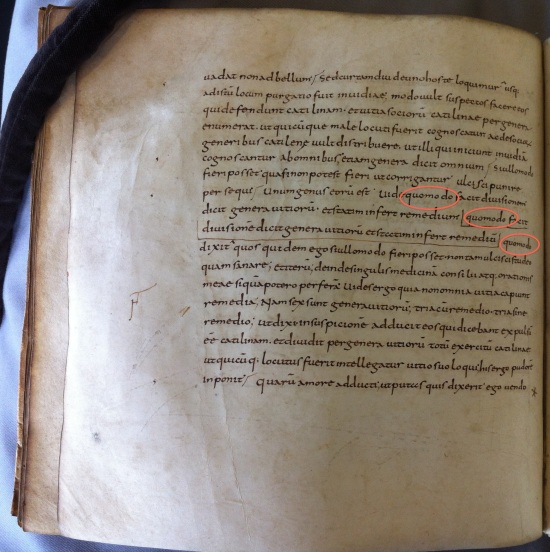By Irene O’Daly
Medieval manuscripts often contain traces unintentionally left behind by the scribe. A casualty of spell-check and mass-production, mistakes in books, like typographical errors, are now usually spotted before they reach the shelves.
One that escaped the printer’s eye: a page from the so-called ‘Wicked Bible’, printed in 1631, with an interesting twist on the Ten Commandments
The medieval scribe wasn’t necessarily so lucky. Copying by hand was an arduous process and mistakes could creep in all too easily. Today I’d like to explore two versions of the most common accidental error made by medieval scribes, that is eyeskip.
Eyeskip occurs when the scribe’s eye literally jumps from one occurrence of a word to the next while copying, and results in either the omission or repetition of words or phrases.
Leiden UB, VLF 30, Lucretius’ De Rerum Natura, f. 22r
This ninth-century book produced at the palace school of the famous emperor Charlemagne is one of the treasures of Leiden’s collection – a copy of the Roman poet Lucretius’ De rerum natura (VLF 30).1] ossa uidelicet e pauxillis atque minutis
2] ossibus hic et de pauxillis atque minutis
3] uiceribus uiscus gigni sanguenque creari
4] sanguinis inter se multis coeuentibus guttis
[Lucretius, De rerum natura I, lines 835-8]
Not only is it one of the earliest medieval copies of the text, but it has been corrected by a scribe whose identity we know – the Irish monk Dungal. We can see Dungal at work on this page (f. 22r).
The change in hand is clearly visible and, moreover, the correction has a sort of squashed aspect. That’s because Dungal has replaced one line of poetry with two – adding something that the original scribe had missed.
If we look at the text of the four lines highlighted above, we can see that lines 1 and 2 are quite similar – both end in ‘pauxillis atque minutis’. Reconstructing the mistake, it’s likely that the scribe omitted line 2, proceeding straight to line 3.
The technical name for the omission of text due to the scribe’s eye skipping from one occurrence of a phrase to the next is haplography.
As we can see Dungal rectified the error by scraping out the misplaced line, then replacing it with the necessary two lines of correct text.
Eyeskip could result in omission, as demonstrated, but could also result in repetition of text.
This manuscript, the Scholiasta Gronovianus (VLQ 130), a tenth-century copy of a collection of commentaries on Cicero’s speeches, contains an example of this type, an error termed dittography.
As we can see, it was noticed by a later reader, who boxed the duplicated line half-way down the page.
Here the problem seems to have been provoked by the recurrence of the word quomodo (as indicated). Rather than moving on to ‘quomodo dixit‘, the scribe’s eye jumped back to the preceding sentence and repeated the line beginning ‘quomodo facit‘.
It’s interesting to note that word-separation is not standardized in this manuscript; its probable that the exemplar from which the scribe was copying was not standardized either, which may have made mistakes of this type even more easy to make.
Mistakes resulting from eyeskip tell us something about the process and pitfalls of copying by hand, and the role of the later corrector/reader. In some cases, we may even find a group of manuscripts where the same accidental error is copied from one to another, allowing us to establish textual relationships between manuscripts, useful for understanding the history of the transmission of a text. So medieval errors, even when corrected, provide a genuine opportunity to learn from mistakes!

No comments :
Post a Comment